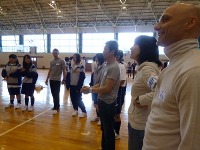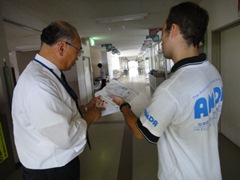The Association for Aid and Relief (AAR) Japan has been carrying out a project to improve the sanitary conditions in evacuation centers in Ishinomaki and Minamisanriku (Miyagi Prefecture), where approximately 1,000 evacuees are still residing. As temperatures and humidity levels have risen, AAR found that many of the blankets and mattresses that were distributed after the earthquake were getting dirty, with some showing signs of mold and ticks. Japanese futons are generally aired out regularly in the sun to prevent such conditions, but it has been difficult to do so in the evacuation centers. Also, a great number of flies and mosquitoes have bred in the areas surrounding the evacuation centers. These conditions have had a serious impact on those with asthma, eczema, and allergies. To reduce the health hazards, AAR has been changing the bedding, airing out futons, carrying out general cleaning, and distributing blanket dryers, vacuums, fans, dehumidifiers, fly paper, insecticides, and other cleaning tools. To prevent food poisoning, they are also delivering refrigerators to evacuation centers. They visited 16 locations between June 14 and July 6.
 JEN reported on a visit in June by members of the Cirque du Soleil cast, who were performing in Tokyo at the time of the earthquake. They held a workshop at a high school in Ishinomaki that is also now providing space for students from an elementary school in Ogatsucho that was destroyed by the tsunami. The performers—including artists from Brazil, Russia, the US, and elsewhere—taught the children juggling, acrobatics, and dance skills, encouraging them to let loose and have fun. The teachers at the school noted that while the students were living in areas that had been damaged in the disaster, the school itself was fine, so they had not received any assistance before this. They were thrilled to see the smiles on the children’s faces for the first time in ages. JEN noted that assistance can come in many forms, and particularly assistance for the emotional recovery of the children requires time and interaction with others. This event gave children a chance to move together with others, interact, and laugh.
JEN reported on a visit in June by members of the Cirque du Soleil cast, who were performing in Tokyo at the time of the earthquake. They held a workshop at a high school in Ishinomaki that is also now providing space for students from an elementary school in Ogatsucho that was destroyed by the tsunami. The performers—including artists from Brazil, Russia, the US, and elsewhere—taught the children juggling, acrobatics, and dance skills, encouraging them to let loose and have fun. The teachers at the school noted that while the students were living in areas that had been damaged in the disaster, the school itself was fine, so they had not received any assistance before this. They were thrilled to see the smiles on the children’s faces for the first time in ages. JEN noted that assistance can come in many forms, and particularly assistance for the emotional recovery of the children requires time and interaction with others. This event gave children a chance to move together with others, interact, and laugh.
 AMDA staff reported on a recent visit to Otsuchi (Iwate Prefecture) and Minamisanriku (MiyagiPrefecture). In the latter location, they met with representatives from Shizukawa Junior High School, which will be participating in a soccer exchange in Okayama in August, presenting the team coach and captain with a soccer ball. They also presented the principal of Shizukawa Elementary School with cards sent from Canadian students to wish their Japanese counterparts a speedy recovery. In Otsuchi, the AMDA staff visited an evacuation center which still had 150 residents as of the end of June. The center has no air conditioning, and is divided up with partitions, so the staff was concerned about residents being susceptible to heatstroke. They spoke with all of the residents and also distributed more of the vitamins that they had given out in the spring as part of AMDA’s nutrition program. As noted by AAR as well, flies have become a big problem, so AMDA handed out flytraps, flyswatters, and bug spray. In addition to evacuation centers, the AMDA staff visited facilities for seniors, hospitals, and other locations, delivering supplies and talking to the people in depth to check on the current needs. In late July, AMDA will be sending doctors to Otsuchi Hospital to assist. Otsuchi Junior High will also be participating in the soccer exchange in Okayama, and AMDA staff joined in one of the team’s practice sessions and presented them with a ball as well.
AMDA staff reported on a recent visit to Otsuchi (Iwate Prefecture) and Minamisanriku (MiyagiPrefecture). In the latter location, they met with representatives from Shizukawa Junior High School, which will be participating in a soccer exchange in Okayama in August, presenting the team coach and captain with a soccer ball. They also presented the principal of Shizukawa Elementary School with cards sent from Canadian students to wish their Japanese counterparts a speedy recovery. In Otsuchi, the AMDA staff visited an evacuation center which still had 150 residents as of the end of June. The center has no air conditioning, and is divided up with partitions, so the staff was concerned about residents being susceptible to heatstroke. They spoke with all of the residents and also distributed more of the vitamins that they had given out in the spring as part of AMDA’s nutrition program. As noted by AAR as well, flies have become a big problem, so AMDA handed out flytraps, flyswatters, and bug spray. In addition to evacuation centers, the AMDA staff visited facilities for seniors, hospitals, and other locations, delivering supplies and talking to the people in depth to check on the current needs. In late July, AMDA will be sending doctors to Otsuchi Hospital to assist. Otsuchi Junior High will also be participating in the soccer exchange in Okayama, and AMDA staff joined in one of the team’s practice sessions and presented them with a ball as well.
